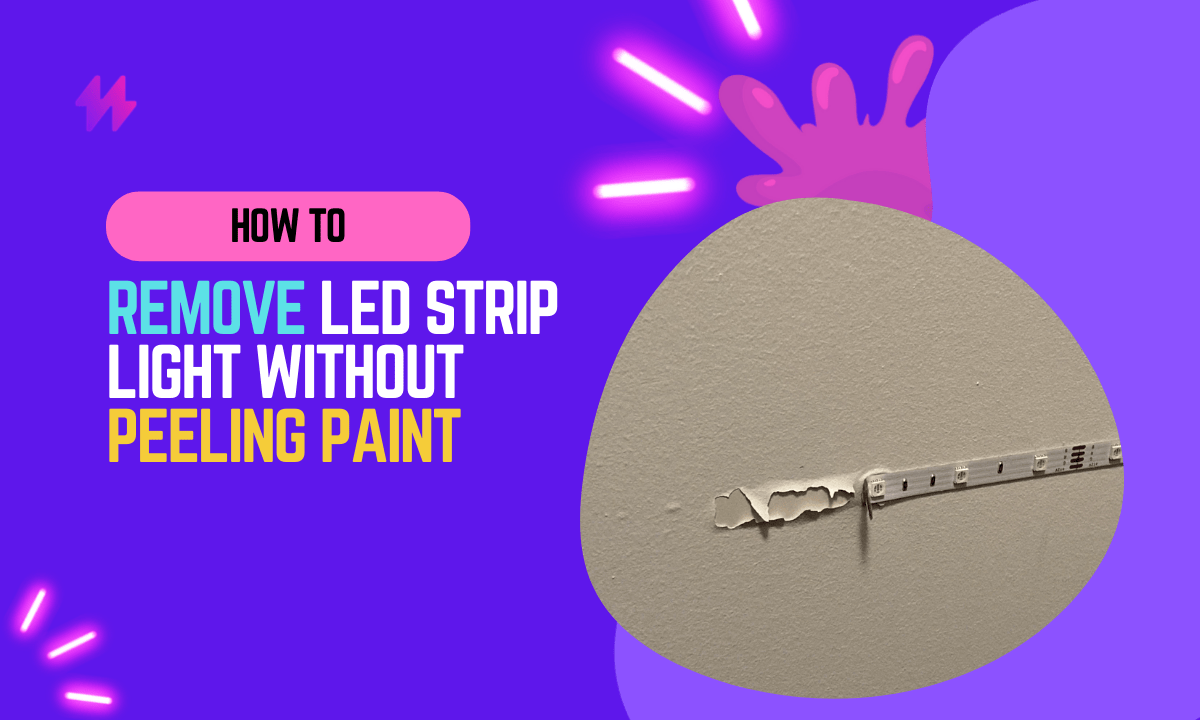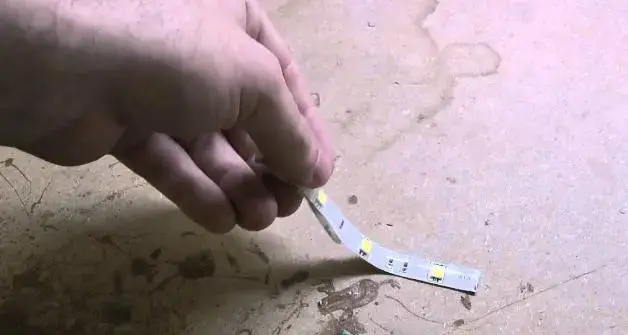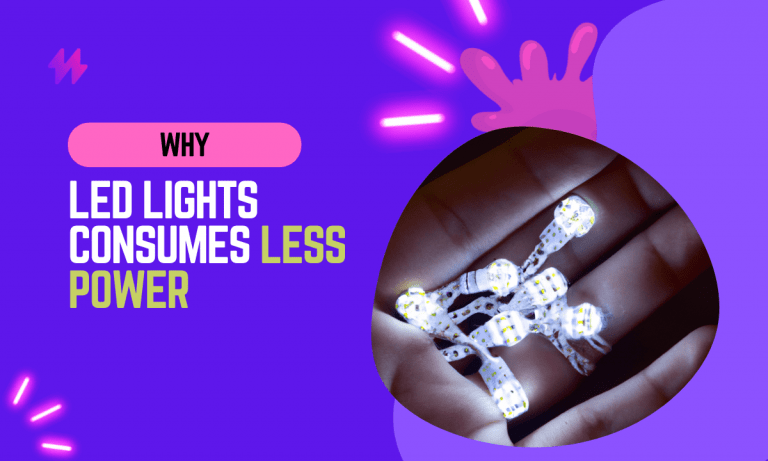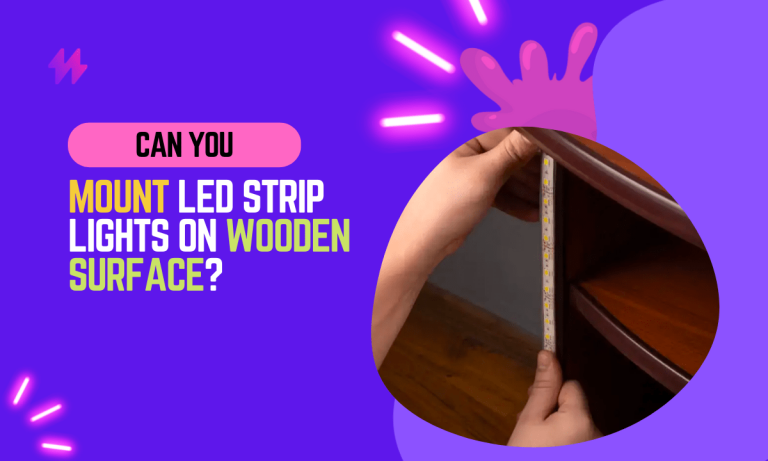How to Remove LED Strip Light Without Peeling Paint

LED lights have become a popular choice for homeowners to add some ambiance and mood to their homes. However, these lights are often attached to walls and other surfaces with adhesive, which can make them difficult to remove without causing damage to the paint. In this article, we will provide a step-by-step guide to help you remove LED lights without peeling the paint.
When removing LED strips, it’s essential to use the right techniques to minimize any unintended paint disturbance. Utilizing a plastic razor blade combined with rubbing alcohol can facilitate a damage-free peeling process while also ensuring the wall surface remains intact, preserving your painted surfaces. Choosing the right adhesive remover can help in the light removals, allowing for a smooth transition to a new lighting setup without the risk of paint peeling. For a well-lit spot in your home, consider touch-up paint for any minor paint chips that may occur during the light removal process, enhancing the aesthetics of the area.
How to Remove LED Strip Light Without Peeling Paint: Essential Equipment Needed
Before we begin, let’s take a look at the tools and materials you will need to remove LED lights without damaging your walls:
To successfully carry out the light removal process without risking damage, having the right tools at hand is crucial. Always keep in mind how to remove LED strip light without peeling paint to ensure your wall surfaces remain intact and the aesthetics of your room are preserved.
- Hairdryer or heat gun
- Plastic card (such as a credit card or spatula)
- Rubbing alcohol
- Soft cloth
- Paint touch-up kit
- Painter’s tape
- Plastic putty knife
- Sandpaper
Comprehensive Step-by-Step Guide: Removing LED Strip Light without Peeling Paint
Now, let’s dive into the step-by-step process to remove LED strip lights without causing damage to the paint.
To effectively remove LED strip lights without damaging the paint, start by carefully using a plastic razor blade to minimize the risk of unintended paint disturbance. After initial peeling, apply an adhesive remover with rubbing alcohol to ensure a safe removal process that preserves the painted surfaces. Incorporating light models with vibrant colors can enhance the aesthetics of any room, making it a well-lit spot for reflection. When dealing with minor paint chips, having touch-up paint on hand can help achieve a flawless finish after light removals.

Preparation for Removing LED Strip Light Without Peeling Paint
- Turn off the LED lights and allow them to cool completely.
- Gather all the necessary tools and place them in a location that is easily accessible.
- Lay down a drop cloth or plastic sheet to protect the surrounding area from any damage.
Effortlessly Removing LED Strip Lights Without Peeling Paint: A Comprehensive Guide
- Use a hairdryer or heat gun to warm up the adhesive that is holding the LED lights to the wall. Hold the heat source at least 6 inches away from the wall, and move it around in a circular motion to heat up the adhesive.
- Once the adhesive is warm, use a plastic card (such as a credit card or spatula) to gently scrape it off the wall. Apply pressure to the card at a 45-degree angle to avoid scratching the paint.
- Apply more heat to the adhesive as needed to soften it up further, and continue scraping until all the adhesive is removed from the wall.
- Use rubbing alcohol on a soft cloth to remove any leftover adhesive. Be sure to test the rubbing alcohol on a small, inconspicuous area of the wall first to make sure it doesn’t damage the paint.
- Clean the area with warm, soapy water and a soft cloth to remove any residue.
Inspect the wall after the removal process is complete. If there is any damage to the paint or drywall, you can use a paint touch-up kit to fix the affected area.
It’s important to take a moment to ensure that the wall surfaces are clean and free from any remnants of adhesive strips after completing the light removals. For a fresh start in your lighting setup, consider using a quality adhesive remover and touch-up paint to restore any mess caused by the peeling process.
Maintenance and Clean-up: Efficiently Remove LED Strip Light without Peeling Paint
- Fill any holes or cracks with a plastic putty knife and spackle. Once it has dried, sand it down with sandpaper until it’s even with the surrounding area.
- Apply a coat of primer to the affected area and let it dry completely.
- Once the primer is dry, use the paint touch-up kit to match the color of the surrounding area. Apply the paint in thin, even coats, and let each coat dry completely before applying the next.
- Once the paint is dry, remove any painter’s tape and touch up any areas that need additional paint.
Also read: Where to put LED lights on the ceiling or walls?
When handling the removal of LED strips, it’s vital to focus on wall surface cleansing to avoid any potential paint damage. Remember, using an effective adhesive removal technique with products like rubbing alcohol can ensure a safe removal process, allowing you to maintain a beautiful, well-lit spot in your home without the worry of minor paint peeling and a messed-up paint job.
Smart Strategies for Removing LED Strip Light Without Peeling Paint | Tips and Tricks

- Be patient and take your time during the removal process. Rushing can cause damage to the wall and paint.
- Use a hairdryer or heat gun to soften up the adhesive before attempting to remove it.
- Use a plastic card to scrape off the adhesive, as metal tools can scratch and damage the paint.
- Test the rubbing alcohol on a small, inconspicuous area of the wall before using it to remove any leftover adhesive.
- Apply the paint in thin, even coats to avoid any drips or bubbles.
FAQs on Removing LED Strip Light Without Peeling Paint
Q. What should I do if the LED lights have been up for a long time and the adhesive is extremely difficult to remove?
A. In cases where the adhesive is extremely difficult to remove, you may need to use a heat gun or apply more heat to the area to soften it up more. If you’re still having trouble, it’s best to consult a professional.
Q. Will this process work on all types of surfaces, or only on painted walls?
A. This process can be used on a variety of surfaces, including painted walls, wallpaper, and tiles. However, be sure to test any solvents or tools in an inconspicuous area to make sure they don’t cause damage.
Q. How long will it take to remove the LED lights and repair any damage to the paint?
A. The time it takes to remove the LED lights and repair any damage to the paint will depend on the size of the area, the amount of adhesive that needs to be removed, and the extent of any paint damage. It’s best to take your time during the removal process and make any necessary repairs carefully to ensure the best results.
You may also like: Can You Put LED Light Strips on Wallpaper?
For stubborn adhesive patches left by LED strips, using a heat gun can effectively soften the residue, preventing any unintended paint disturbance during removal. Additionally, after removing the LEDs, consider applying touch-up paint to address any minor paint chips and maintain the aesthetics of your well-lit spots.
Final Thoughts on Removing LED Strip Light Without Peeling Paint
In conclusion, removing LED strip lights without damaging the underlying paint requires a careful and methodical approach. This is particularly important in maintaining the aesthetics of the space once the lights are no longer needed or when repositioning them for better lighting effects. The key to a successful removal lies in gently loosening the adhesive backing of the LED strips. This can often be achieved by applying heat to the strips with a hairdryer set on a low heat setting. The gentle warmth softens the adhesive, allowing the strips to be peeled off slowly and carefully without pulling up paint or leaving residue behind. This technique ensures that the surface remains intact, preserving the visual integrity of the wall or fixture.
Furthermore, if remnants of adhesive do remain on the surface after removal, they can typically be cleaned off with a soft, clean cloth and a mild solvent like isopropyl alcohol, which helps break down the adhesive without harming the paint. It is important to perform this cleaning gently to avoid saturating the paint and causing discoloration or damage. For those planning to reinstall LED strip lights or replace them frequently, considering the use of non-permanent adhesives or mounting tracks that allow for easy removal and adjustment can be a more suitable option. These preparations not only protect the surface and paint but also provide greater flexibility in changing lighting arrangements as needed. By following these simple yet effective tips, you can ensure that your LED strip lights can be updated or removed as required without costly damage to your interior décor.
How To Remove LED Strip Light Without Peeling Paint | Tools and Materials for Removing LED Strip Lights
Removing LED strip lights without damaging painted surfaces requires a careful approach to preserve the aesthetic integrity of the area. Understanding how to remove LED strip light without peeling paint involves selecting the right tools and materials. Using a plastic razor blade can help gently lift the LED strip line, minimizing the chance of paint damage. Adhesive removers, particularly citrus-based cleaners, are effective at breaking down old adhesive without harsh effects on paints. For areas like vanity mirrors or worktop illumination, ensuring a damage-free peeling experience is crucial. Avoiding forceful removal methods protects both the surface and the light, allowing for a smooth transition to new color-changing lights or other LED variations that enhance aesthetics. A good clean of the surface after removal will help maintain its vibrant glow, ensuring it looks as good as new.
How to Remove LED Strip Light Without Peeling Paint | Recommended Tools for a Safe Removal
Removing LED strip lights without peeling paint requires the right tools to ensure a smooth process. A heat gun or a hairdryer is essential for gently loosening the adhesive. Waxing the surface can also help to protect it as you work, preventing paint damage that often occurs when removing adhesive materials. It’s important to choose light models that suit your space, as vibrant lights enhance aesthetics in any room. Pay attention to the direction of the light; a low angle can reveal the strip’s adhesive more clearly, making removal easier.
Using a plastic scraper or a credit card can aid in safely lifting the LED strip without harming the underlying paint. These tools are particularly effective on uneven surfaces where paint damage can be a concern. Prior to starting the removal process, ensure you have a clean workspace and all recommended tools on hand. Knowing how to remove LED strip light without peeling paint can save time and stress while preserving the integrity of your walls.
Essential Materials to Protect Surfaces
To ensure a successful removal of LED strip lights, it is vital to have protective materials ready. Using a drop cloth or tarp can shield the floor from potential debris or adhesive residue. Masking tape can also be employed to cover nearby edges or surfaces that may be at risk. This preparation step is crucial for those wondering how to remove LED strip light without peeling paint, as it provides a buffer against potential paint damage.
Consider utilizing a plastic scraper or putty knife for carefully lifting the LED strips without damaging the surface underneath. These tools help minimize the risk of scratching or gouging the walls while allowing for a smooth removal of vibrant lights that transition your space. Knowing the right materials to use will make the process easier and prevent unwanted damage, addressing the common concern of how to remove LED strip light without peeling paint.
Techniques to Minimize Paint Damage
Removing LED strip lights can be a delicate task, especially for those concerned about how to remove LED strip light without peeling paint. Paint damage occurs often when the adhesive on the strip is too strong or if the paint is not properly bonded to the surface. To avoid this, utilizing techniques that minimize risks is essential. For example, one effective method involves gently heating the adhesive, which can allow for a smoother transition without pulling the paint away from the wall. Exploring chemical solutions can also provide a safer alternative, ensuring that the vibrant lights transition does not come at the cost of your wall’s finish. By employing these strategies, the process of removal becomes much simpler and less damaging.
Using Heat for Easy Removal
Applying heat can be an effective method for removing LED strip lights while minimizing the risk of peeling paint. A heat source, such as a hairdryer or heat gun, can soften the adhesive used on the strip, making it easier to detach. It’s important to use a low heat setting to prevent damage to the shade or surrounding surfaces. Understanding how to remove LED strip light without peeling paint is crucial in these situations, as excessive heat can cause unwanted issues.
Begin by holding the heat source a few inches away from the LED strip. Move it back and forth along the length of the strip for a few seconds to gradually warm the adhesive. Once the adhesive has softened, gently pull the strip away from the surface, applying steady pressure. This method demonstrates a practical approach to how to remove LED strip light without peeling paint, ensuring that the paint remains intact while achieving the desired result.
Chemical Solutions to Aid in Safe Removal
Using chemical solutions can be an effective way to assist in the removal of LED strip lights without causing damage to your walls. A common approach involves applying adhesive removers or solvents specifically designed for this task. These products work by softening the adhesive, making it easier to peel off the LED strip. Knowing how to remove LED strip light without peeling paint is crucial, as improper techniques can lead to unsightly marks or damage.
Before applying any chemical solution, it’s essential to test it on a small, inconspicuous area first. This step ensures that the solvent doesn’t react negatively with your paint or surface material. Once confirmed safe, apply the solution generously to the adhesive and allow it to sit for several minutes. This method not only makes the job easier but also minimizes the risk of peeling paint, ensuring a cleaner removal process.
Steps to Follow for Successful Removal
Successful removal of LED strip lights requires careful preparation and execution to avoid damaging the paint underneath. Understanding how to remove LED strip light without peeling paint is crucial for maintaining the integrity of your walls. Before starting, ensure the area is clear and gather all necessary tools. Using a heat source can help soften the adhesive, making it easier to peel away the led strip. A methodical approach will minimize risks, allowing you to effectively remove the led strip without causing any harm to your painted surfaces. Knowing how to remove LED strip light without peeling paint can save you time and effort in touch-up work later on.
Preparing the Area Before Removal
Prior to moving forward with the removal of your LED strip light, it’s essential to create a clean and organized workspace. Gather all necessary tools and protective materials to ensure a smooth process. Knowing how to remove LED strip light without peeling paint begins with proper preparation. If the led strip isn’t properly removed, it could lead to unintended damage to your walls or surfaces.
Clear the area around the light strip to ensure you have ample space to work. Cover furniture and flooring with drop cloths or plastic sheeting to protect them from any potential debris. Having a designated area for your tools will streamline the removal process. By setting the scene for success, you reinforce your understanding of how to remove LED strip light without peeling paint.
StepbyStep Removal Process
Begin by carefully assessing the LED strip light installation. Check for any clips or mounting hardware that may be securing the strip in place. Knowing how to remove LED strip light without peeling paint requires an understanding of the strip’s attachment method. If the strip is adhered with adhesive tape, taking your time will help prevent damage to the underlying paint.
To detach the strip, gently pull one end while supporting the surface behind it. Gradually peel away the strip at a low angle instead of pulling straight off. This technique minimizes the risk of paint damage. Using a plastic scraper may assist in loosening stubborn sections. Remember that knowing how to remove LED strip light without peeling paint involves patience and careful movements throughout the process.
Conclusion
Removing LED strip lights can be a delicate process, especially when aiming to preserve your paint. Knowing how to remove LED strip light without peeling paint is essential for maintaining the integrity of your walls. Utilizing the recommended tools and materials can make this task much simpler. Techniques such as gentle heat application or chemical solutions can help loosen the adhesive without causing damage. By preparing the area properly and following a step-by-step removal process, you can achieve successful results while keeping your paint intact. Understanding how to remove LED strip light without peeling paint empowers you to refresh your space with confidence.






